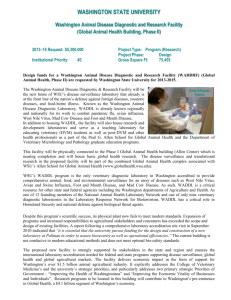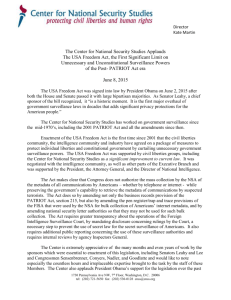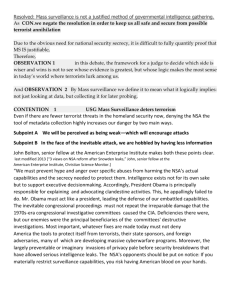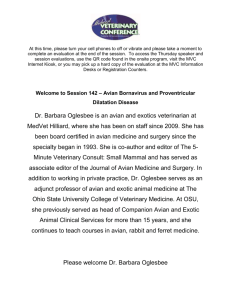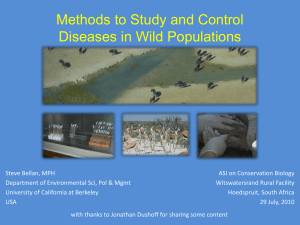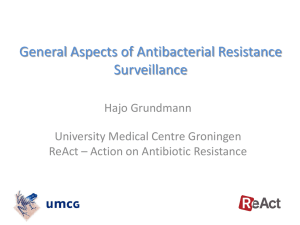Animal Disease Response Training
advertisement
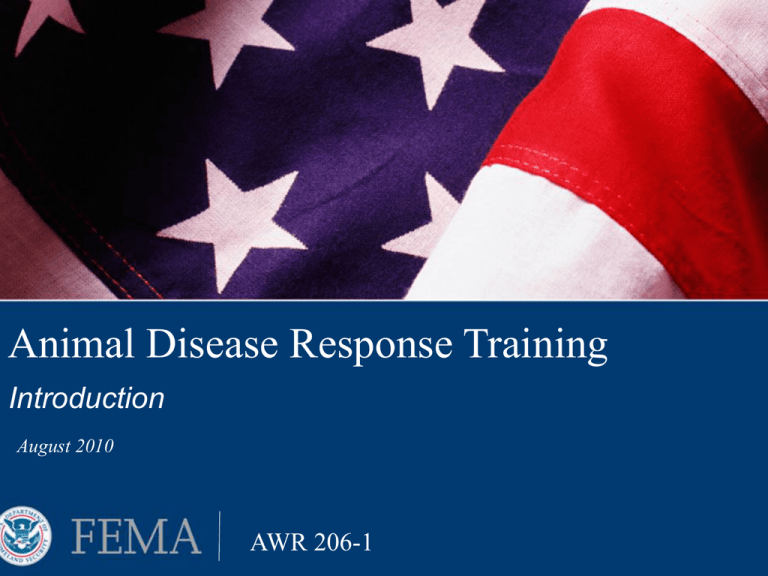
Animal Disease Response Training Introduction August 2010 AWR 206-1 Animal Disease Response Training Scope Statement • The participant will gain an appreciation for the vulnerability of U.S. agriculture to animal disease threats, be introduced to the factors that trigger response efforts, and understand the important role of responders in an agricultural emergency and gain appreciation for the role of unified command. This lesson will also address continuity of business and issues of traumatic stress. 1 Animal Disease Response Training Terminal Learning Objective • Review the elements of an animal disease emergency and understand the critical role of responders. Animal Disease Response Training Enabling Learning Objectives 1-1 1-2 1-3 1-4 1-5 Define agriculture emergency and recognize vulnerabilities of agriculture systems. Identify the various groups, authorities, and jurisdictions that will play major roles in a foreign animal disease event. Identify the steps to determine the presence of disease, process of diagnostics and surveillance, and the need for deployment of personnel. Discuss the importance of continuity of business planning within a control zone. Define traumatic stress as it relates to a foreign animal disease response. Animal Disease Response Training What is an Agriculture Emergency? • Any event that jeopardizes the economic stability of any portion or segment of the agriculture or agribusiness industry. – Pre and Post Harvest • Naturally occurring • Intentional introduction – CBRNE Animal Disease Response Training Understanding the Targets • • • • • • • • Transportation systems Water supplies Grain elevators Producers, farmers, farm workers Restaurants and food handlers Grocery stores Food and agriculture research labs Packing and processing facilities Animal Disease Response Training Introduction of Disease Unintentional threats • Natural • Point of origin is unknown • West Nile, Chronic Wasting Disease • Accidental • Known point of origin – Contamination of feed – Improper processing Animal Disease Response Training Introduction of Disease Intentional introduction • Criminal • Act of Terrorism (AgroTerrorism) • Targets economy Animal Disease Response Training Vulnerability • • • • • Geographical dispersion and concentration Comingled products from many sources Consolidation of agribusinesses Extensive movement of animals Inadequate biosecurity Animal Disease Response Training Susceptibility Animal diseases make good terrorism agents • rapidly spread • spread facilitated by wildlife or humans • difficult to kill and persist in environment • difficult to trace, go undetected for long periods • global sources exist and easily accessible Animal Disease Response Training Achievability • Motivation • Opportunity • Technical Ability • Goal • Willingness to utilize biological weapons Animal Disease Response Training Transmissible Animal Diseases Zoonotic • Transmitted from animals to humans • Represent source of emerging infectious disease Avian Influenza Brucellosis Tularemia Rabies Lassa fever Listeriosis West Nile virus Trichinosis Swine Flu Lyme Disease Vesicular stomatitis Animal Disease Response Training Transmissible Animal Diseases Zoonotic diseases can spread through: • Direct contact • Drinking water containing parasites • Eating raw or contaminated animal products • Insect vectors Primates Cats Dogs Pigs Horses Cattle Rodents Rabbits Bats Animal Disease Response Training Transmissible Animal Diseases Non-zoonotic • Non-infectious to humans • Humans may still transmit Foot and mouth disease African swine fever Rinderpest Hog cholera Vesicular exanthema Bovine Pleuropneumonia Animal Disease Response Training Routes of Transmission • • • • • Direct Contact Ingestion Airborne Fomites Vectors Animal Disease Response Training Laboratory Diagnostics and Disease Surveillance Diagnosis • Requires organism isolation in lab • Poultry – tracheal or cloacal swab • Livestock – blood or secretions Laboratory Confirmation • Only federal lab can confirm • Plum Island (FMD) • NVSL (Avian Influenza) Animal Disease Response Training Laboratory Diagnostics and Disease Surveillance Surveillance • USDA both domestic and international roles • Domestic prevention efforts • Collaboration with USAID and HHS for avian influenza H5 and H7 Animal Disease Response Training Vaccination in an Animal Disease Outbreak • Dependent upon state and federal epidemiological assessment and managed by USDA/APHIS Animal Disease Response Training Vaccination Assessment • Probability of disease containment • Proximity of high value animal agriculture • Threat to valuable, rare or endangered nondomestic species • Density of animals at risk • Extent to which wildlife is involved • Availability of staff to carry out vaccination efforts • Public opinion • Potential for zoonotic infection • Impact on export markets • Economic impact of failing to control the disease Animal Disease Response Training National Veterinary Stockpile • Provides equipment, field tests, vaccines and other support services that states need in response to an animal disease outbreak. Animal Disease Response Training Animal Health Response Agencies • Informs governments about diseases worldwide and recommends means of control • Coordinates international disease surveillance and control • Coordinates regulations for international trade in animals and animal products Animal Disease Response Training Animal Health Response Agencies Protect and promote the growth of U.S. agriculture • Addresses animal and plant disease events – Border inspections – Animal import testing – Training for foreign animal disease detection • Protect, detect, contain, control disease – – – – Wildlife Services NAHERC FADD AVIC Animal Disease Response Training State Animal Health Response Agencies Department of Agriculture or Board of Animal Health • State Veterinarian • Foreign Animal Disease Diagnosticians (FADD) Oversight of animal health related activities • Surveillance • Quarantine • Movement permits • Disease investigation • Licensing or registration Animal Disease Response Training Integrated Response ICS/Unified Command • • • • Overall management of incident Directs activities Releases resources Implementation of strategies Animal Disease Response Training ICS Structure Animal Disease Response Training Reaching a Diagnosis • Local producer or veterinarian notices problem • Notification of state or federal animal health authorities • Field sample collection by a Foreign Animal Disease Diagnostician (FADD) • Diagnosis confirmed by a federal laboratory – Plum Island for Foot and Mouth disease – NVSL for Avian Influenzas • National Animal Health Laboratory Network (NAHLN) – Responds to overflow and additional confirmations Animal Disease Response Training Case Classification – Suspect • Animals with clinical signs of disease – Presumptive Positive • Animals with clinical signs and positive initial testing • Quarantine of premises, surveillance and biosecurity measures will be implemented immediately Animal Disease Response Training Case Classification • Confirmed Positive – Animals with clinical signs and isolation and identification at a USDA laboratory • FADDL – Plum Island • NVSL – Ames, Iowa Animal Disease Response Training Economic Impact • Production losses • Overall response effort costs • Loss of animals and genetics • Loss of international trade, exporting barriers Animal Disease Response Training Economic Impact • Lost income for farmers, producers • Movement restrictions impacting tourism, hunting • Higher prices for consumer commodities • Economic losses to local businesses via reduction in consumer spending Animal Disease Response Training What is Continuity of Business? • Goal of eradicating disease may be contrary to continuity of operations on nearby farms • Return to business-as-usual will prove to be challenging • Some priorities may be resolved prior to outbreak – Raise awareness – Establish policies – Develop plans – Identify resources Animal Disease Response Training Stress Factors • Individuals may feel overwhelmed and suffer deficits in: – – – – – Cognitive abilities Emotional stability Physical well-being Spiritual functioning Relationships Animal Disease Response Training What Steps Can Help Manage Stress? • Self examination • Mental attitude of self care • Knowing what types of incidents and sensory experiences trigger emotional response Smells Sounds Sights Feelings Animal Disease Response Training Summary • Our agriculture system is vulnerable to animal disease. • Many groups participate in response to an agriculture emergency. • Important to understand the steps necessary to determine the presence of disease. • Continuity of business is essential to maintain. • Economic and emotional stress imposed on producers and communities.
